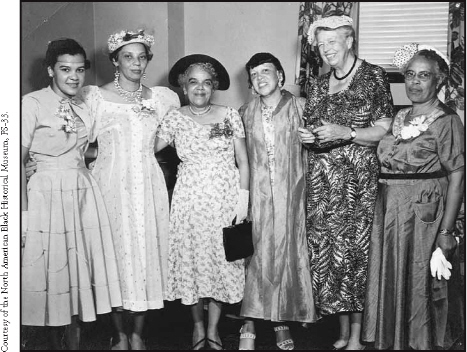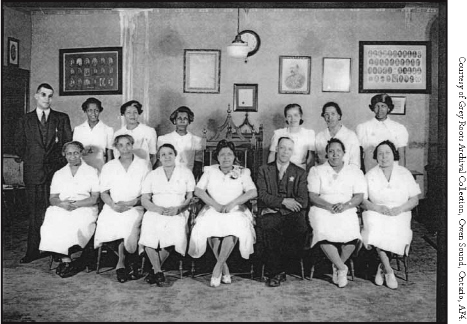

The Role of Women in Emancipation Day Celebrations
When I liberate others, I liberate myself.
— Fannie Lou Hamer, “The Special Plight and Role of Black Women,” from speech delivered in 1971.
African-Canadian women played key roles in Emancipation Day commemorations. During the nineteenth century women’s involvement was primarily, but not limited to, behind the scenes. The restrictions of the Victorian period and certain standards of civic conduct and social order were placed on women. All women were excluded from many aspects of public venues, and for Black women this sometimes meant exclusion from parts of the August First programming. In St. Catharines in 1835, “after the removal of the cloth, and the withdrawal of the ladies, the following toast were drank….”1 Women did not have full citizenship rights, they could not vote or own property (though they could inherit property and keep it in their name), and they could not obtain professional employment, unless in the capacity of a teacher. Employment opportunities were largely limited to working as a seamstress or running a boarding house. A number of Black women earned an income working as domestic servants and washerwomen. Generally women were expected to obey their husbands, bear children, and take care of the home. These social mores influenced the extent to which women could participate in early Emancipation Day celebrations.
It does not appear that any women were engaged as speakers at any time in the 1800s in Canada, with the possible exception of Mary Ann Shadd. She may have addressed the Toronto audience in 1854 when she returned from a tour to raise funds for the operation of the Provincial Freeman by selling subscriptions to the newspaper, but no record of her having done so has been located. However, Shadd did not get or search for the detailed coverage received by male speakers. It was not customary to heavily publicize female activities and male subscribers likely would have disapproved to the point of causing financial harm to the paper. Shadd used her initials in the Provincial Freeman until the fall of 1854, and when her identity was revealed the backlash charged that the newspaper had “Editors of the unfortunate sex.”2 The first Black female speaker to be publicly recorded was Mary McLeod Bethune, civil rights activist and advisor to President F.D. Roosevelt, in 1954 at Windsor’s Emancipation Day, 120 years after the liberation of enslaved African men and women. Then, in 1958, lawyer Violet King delivered an address in Toronto. In keeping with the times, the chairperson for the August First celebratory events was always male — no woman would ever have been considered for that role.
However, the role that African-Canadian women played should in no way be minimized. Their work and labour was integral to the success of these annual civic and social events. As members of the planning committees, women helped to raise money for the various Emancipation Day festivities. They were responsible for creating a comfortable, welcoming atmosphere through the decoration of the many halls and venues they used, and for preparing literally tons of much-appreciated food. Their innovative community activism was harnessed on every August First holiday. Black women used Emancipation Day to fundraise in support of other social issues impacting Black citizens. When waves of fugitives arrived in Canadian centres, it was the women of the community who ensured that newcomers had food, clothing, and shelter.
By the end of the nineteenth century, women were playing a more visible role in August First events. Increasingly, women appeared in public street processions, marching with the benevolent societies they were members of, such as the Household of Ruth, Daughters of Samaria, and the Star of Calanthe in London in 1896. For example, the Household of Ruth, made an appearance in an event in Hamilton in 1884: “The Household of Ruth … is an organization composed entirely of women, and the Toronto and Hamilton branches of it took part in the demonstration….”3

Women played a major role in the Emancipation Day celebrations in Windsor in 1954. Pictured here (from the left) are three unidentified members of the Hour-A-Day Study Club; Genevieve Allen-Jones; First Lady Eleanor Roosevelt, wife of President F.D. Roosevelt; and Mary McLeod Bethune.
Women performed regularly at Emancipation Day, singing solos or as members of choirs or ensembles. These were roles that were considered respectable, as the music realm was not as restrictive as other aspects of life. By the 1900s, women of African descent were providing a variety of entertainment features. One notable example was Dorothy Darby, an African-American parachute jumper from Ohio who jumped from a plane into Jackson Park in Windsor, Ontario, in August 1938:
The crowd dwindled as the dinner hour approached, but swelled again as the throb of an airplane motor was heard approaching from Detroit. All eyes strained upward, until a tiny white speck had grown into an airplane. Then a dot of white fell from the plane, and plummeted toward earth. Its descent was halted suddenly when a white parachute opened and Miss Dorothy Darby, premier woman parachute jumper, completed her 38th jump, and landed on the grounds.4

Like other female auxiliaries, these women would have been involved in community outreach, providing help by way of financial support, finding housing and employment, aiding the sick and the elderly, and fundraising for various community causes. This is a photo of the ADAH Chapter No. 7 Scenic City Lodge 22 in Collingwood and Owen Sound, Ontario.
Women also performed dance routines, acted in plays, and participated in the Miss Sepia International Beauty Pageant, a popular feature of “The Greatest Freedom Festival on Earth” initiated in Windsor.
The shift in social mores with each passing generation also impacted the visibility and participation of women in Emancipation Day commemorations. As the public sphere become more receptive to the female presence, women’s involvement increased. Today, women are active in all aspects of August First celebrations, including headlining as speakers, artists, authors, storytellers, and musicians. Black and White women — like Lisa Scott of the Emancipation Festival in Owen Sound, Ontario; Daphney Laraque of the UNIA in Montreal, Quebec; and Anne Jarvis, Historical Interpreter at Griffin House/Fieldcote Memorial Park and Museum in Ancaster, Ontario — have taken on the role as organizers. The reach of freedom and liberation extended not only to people of African descent, but to the female gender as well. These examples are testament to how far Black women, and women in general, have come since emancipation during the Victorian Era.